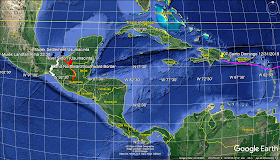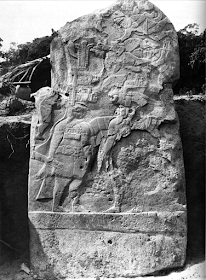The Mulekite capital, the city of Zarahemla, was west of a dominant river called Sidon Alma 2:15, 34. Sidon was a major port in ancient Phoenicia. The modern Sidon, Lebanon, is midway between Beruit and Tyre.
 |
| The Mediterranean Port City, Sidon, in Context |
 |
| Philip Beale, British Banker Turned Explorer |
- Phoenicians could have circumnavigated Africa ca. 600 BC just as Greek historian Herodotus (ca. 484 BC - ca. 425 BC) says they did.
- Phoenicians could have sailed from the Old World to the Americas ca. 600 BC.
 |
| Phoenicia, Working Phoenician Ship Replica |
 |
| Phoenicia Circumnavigation of Africa 2008-2010 |
 |
| Phoenicia Transatlantic Crossing 2019 |
 |
| Ocean Currents per National Geographic |
 |
| Proposed Mulekite Landfall, Settlement in Context Compared with Phoenicia December 31, 2019 Landfall |
After staying in Santo Domingo for 19 days, Beale and crew sailed around Haiti, then northward to Florida, but this leg of their journey required auxiliary power from an emergency motor to get through the tempestuous strait known as the Windward Passage between Haiti and Cuba. Phoenicia landed in Fort Lauderdale on February 4, 2020.
Philip Beale and Phoenicia followed many other seafarers who traveled similar routes. This map shows the four voyages of Christopher Columbus in 1492 - 1502 and two voyages of Thor Heyerdahl in working replicas of ancient reed vessels. All six voyages passed through the Canary Islands and ended up in or near the Caribbean.
 |
| Columbus, Heyerdahl, and Phoenicia Expeditions All Following Similar Routes |
 |
| 93 Human Powered Voyages that Followed Transatlantic Ocean Currents |
Known historical examples of transatlantic ocean voyages made under circumstances similar to those the Mulekites would have encountered strongly suggest passage through the Canary Islands to the Caribbean.
--
The land southward was divided into the land north where Mulek landed and the land south where Lehi landed Helaman 6:10. Most serious Book of Mormon geographers consider the Mexican states of Tabasco and Chiapas to be part of the land southward along with Guatemala and Belize. This map shows locations per the SNHAAPMT Book of Mormon geography model.
 |
| Proposed Mulekite Landings in Context |
Second Line of Reasoning
Tabasco is in the northern portion of what many consider the land southward, which fits Helaman 6:10.
--
Ancient iconography at La Venta strongly supports the idea of foreign visitors about the time the Mulekites would have landed. This is the famous La Venta Stela 3 dubbed the "Uncle Sam" stela which dates to 600 - 550 BC.
 |
| La Venta Stela 3 Excavated by Matthew Stirling in 1943 |
 |
| Bearded Foreigner Depicted on La Venta Monument 13, Photo by Linda Schele |
Third Line of Reasoning
If La Venta stone carvings do not represent Mulekite/Olmec interaction, they show people with physical features similar to those we would expect in a Mulekite population visiting the Olmec capital at about the time the Mulekites arrived in the New World.
--
Ca. 600 BC, the Phoenicians and the Greeks were in a major competition to settle the entire Mediterranean shoreline and establish trading colonies. This map shows Greek colonies in blue and Phoenician colonies in red.
Notice where these two colonial powers established settlements: along the sea coasts with cities at good harbors or along large navigable rivers. Theirs were maritime rather than inland empires. This tells us something about where a joint Mulekite/Phoenician expedition to the Americas would likely establish a capital city such as Zarahemla. Ocean-going vessels could sail up navigable rivers. In fact, ships through the ages have purposely sailed upstream on large rivers to rid their hulls of barnacles. Barnacles die and fall off in freshwater. Rivers, though, are only navigable to the fall line which is the place, usually at an escarpment, where severe rapids or a waterfall prevent upstream boat travel.
 |
| Greek (Blue) and Phoenician (Red) Colonies ca. 550 BC |
The SNHAAPMT model correlates the city of Zarahemla with the ancient pre-classic site of Nueva Esperanza/Calatraba in northern Chiapas. The site is riverside west of the Usumacinta in the coastal plain upstream from the perennial flood zone and downstream from the fall line.
 |
| Proposed Zarahemla in the Coastal Plain Between Swamps and Mountains |
Given what we know of Phoenician settlement patterns in the Old World, we would expect them to favor a city site close to the seacoast at a good harbor or along a large river downstream from the fall line. The Usumacinta in Tabasco and northern Chiapas is such a setting.
--
The Jaredite final battles had a massive casualty count. Ether 15:2 talks of 2 million slain. The bones mentioned in Alma 22:30 and the bones, ruins, plates, breastplates, swords, etc. mentioned in Mosiah 8:8-11 were likely strewn over a sizable area in the general vicinity of hill Ramah/Cumorah. The proposed site of the Mulekites first landing, the mouth of the ancient Grijalva, modern Tonala, is 60 air kilometers from the most likely Ramah/Cumorah - Cerro San Martín Pajapan.
 |
| Proposed Mulekite Landfall 60 Air Kilometers from Likely Ramah/Cumorah |
 |
| Dozens of Known Archaeological Sites in the Olmec Heartland |
The proposed first Mulekite landing near La Venta in the Olmec heartland could reasonably have been proximate to the massive destruction mentioned in Alma 22:30 and Mosiah 8:8-11.
--
April 20, 2020. I have just learned after readiing Kees Noreen, et al. "The Usumacinta-Grijalva beach-ridge plain in southern Mexico: a high-resolution archive of river discharge and precipitation" in Earth Surface Dynamics, 5 (2017) pp. 529-556 that until ca. AD 1,050 the apex flow of the Usumacinta discharged where the San Pedro y San Pablo distributary flows tdoay, at Barra San Pedro. This would put the proposed Mulekite second landing 23 kilometers further east along the Tabascan coast than the maps above show. For more details on the movement of streamflows along the coast of Tabasco from Jaredite times to the present, see the blog article "Wandering River."
Article last updated April 20, 2020
--
Some Book of Mormon modelers over the years have tried to correlate La Venta with the city of Mulek based on the likely Mulekite/Olmec interaction in the Olmec capital recorded on stone monuments such as Stela 3 and the Nephite cultural pattern of naming cities after their founder Alma 8:7. There are three problems with this logic. First, La Venta was the Olmec capital ca. 800 BC and was a thriving city long before Mulek arrived on the scene. Second, Royal Skousen continually reminds us that the original manuscript of the Book of Mormon spells the name of the son of Zedekiah "Muloch" rather than "Mulek" which is the name of the city on the Nephite east coast near the city Bountiful. And third, Muloch was a Mulekite, not a Nephite. The Mulekites arrived in the New World ca. 586 BC and Mosiah I did not lead a group of Nephites from the city of Nephi to the lesser land of Zarahemla until ca. 200 BC. So, any name La Venta carried in Book of Mormon times is much more likely to have been Jaredite or Mulekite than Nephite. The name "Sidon" for instance, was probably applied by the Phoenicians/Mulekites to their dominant river and then simply adopted by the Nephites.
--
So, in summary, the SNHAAPMT model which has passed a rigorous audit with a perfect score of 100% places the first Mulekite landfall at the mouth of the ancient Grijalva, modern Tonala river not far from La Venta. The model predicts the second Mulekite landfall was at the mouth of the Usumacinta which led to settlement immediately upstream of the permanent wetlands. This correlation represents a convergence of several lines of reasoning:
- The Caribbean is an overwhelmingly likely landing place for any ancient voyage passing through the Straits of Gibraltar and the Canary Islands on its way to the Americas.
- Tabasco is in the northern tier of a viable land southward as the text requires and the Usumacinta area had wilderness characteristics when the Mulekites first arived.
- Monuments at La Venta dating to the Mulekite time period record the visit of foreign people whose beards and facial features would have been at home in ancient Jerusalem.
- Known Phoenician settlement patterns in the Mediterranean during Mulekite times accommodate an initial landfall in Tabasco with a capital city on a large navigable river.
- The proposed first landing near La Venta is in the Olmec heartland which can reasonably accommodate the Jaredite destruction narrative including a likely hill Ramah/Cumorah.
--
April 20, 2020. I have just learned after readiing Kees Noreen, et al. "The Usumacinta-Grijalva beach-ridge plain in southern Mexico: a high-resolution archive of river discharge and precipitation" in Earth Surface Dynamics, 5 (2017) pp. 529-556 that until ca. AD 1,050 the apex flow of the Usumacinta discharged where the San Pedro y San Pablo distributary flows tdoay, at Barra San Pedro. This would put the proposed Mulekite second landing 23 kilometers further east along the Tabascan coast than the maps above show. For more details on the movement of streamflows along the coast of Tabasco from Jaredite times to the present, see the blog article "Wandering River."
Article last updated April 20, 2020










